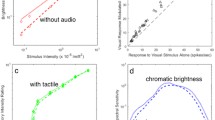Abstract
Adaptation is a fundamental property of human perception. Recently, it was found that there are two opposite types of adaptation to repetitive stimuli with a temporal difference. In this article, we construct an integrative model of adaptation. We model the perception as a Bayesian inference, and represent the two types of adaptation as changes in the likelihood function and the prior distribution in the Bayesian inference. We examine our model analytically and show how the types of adaptation depend on model parameters.
Similar content being viewed by others
Explore related subjects
Discover the latest articles, news and stories from top researchers in related subjects.References
Tootell RBH, Reppas JB, Dale AM, et al (1995) Visual motion aftereffect in human cortical area MT revealed by functional magnetic resonance imaging. Nature 375(6527):139–141
Sato Y, Toyoizumi T, Aihara K (2007) Bayesian inference explains perception of unity and ventriloquism aftereffect: identification of common sources of audiovisual stimuli. Neural Comput 19(12): 3335–3355
Fujisaki W, Shimojo S, Kashino M, et al (2004) Recalibration of audiovisual simultaneity. Nat Neurosci 7(7):773–778
Miyazaki M, Yamamoto S, Uchida S, et al (2006) Bayesian calibration of simultaneity in tactile temporal order judgment. Nat Neurosci 9(7):875–877
Author information
Authors and Affiliations
Corresponding author
Additional information
This work was presented in part at the 14th International Symposium on Artificial Life and Robotics, Oita, Japan, February 5–7, 2009
About this article
Cite this article
Sato, Y., Aihara, K. Integrative Bayesian model on two opposite types of sensory adaptation. Artif Life Robotics 14, 289–292 (2009). https://doi.org/10.1007/s10015-009-0675-0
Received:
Accepted:
Published:
Issue Date:
DOI: https://doi.org/10.1007/s10015-009-0675-0




